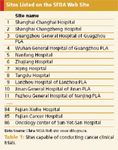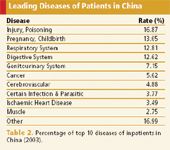Clinical Trial Opportunities in China
Stricter regulations & low costs are attracting more multinationals to the country, but hurdles still exist.
In recent years China's legal system governing pharmaceutical research, production, and marketing has been substantially modified. The country has been working on streamlining regulations and aligning itself with international standards of practice. Clinical trial activity in China is increasing, and in accordance with World Trade Organization requirements.

The first version of Good Clinical Practice (GCP) regulations was issued in 1998 by the Ministry of Health (MOH). After the establishment of the State and Drug Administration (SDA)—now the State Food and Drug Administration (SFDA)—the SFDA formally issued its GCP regulations on September 1, 1999. The latest version was issued in 2003 after both the new Drug Administration Law (2001) and the new Drug Registration Procedure (2002) went into effect.
According to SFDA's data, the number of multicenter clinical trial applications in the first half of 2003 was almost as large as the combined total in 2001 and 2002. This may be an indication that multinational companies are recognizing the advantages of conducting trials in China.
The research environment
Conducting multinational clinical trials is a new phenomenon to China, and there are some local practices that differ from other countries, which can affect the way trials are conducted.
A multinational company conducting trials in China may face a number of issues, including a lengthy approval process (6–12 months), language barriers (oral and written), and the task of setting up a local central lab—export of whole blood/DNA is restricted or prohibited in China. In addition, qualified logistic support is limited (e.g., central storage, IVRS, fax line, broadband for EDC). As a result, multinational companies may have to rely on CROs familiar with local customs and practices.
In China, only hospital centers designated by SFDA are authorized to conduct trials. The hospitals' principal investigators (PIs) often have extensive experience with Western companies. Domestic investigators also want to be involved in international multicenter trials. The investigators at the centers are well-known professors who have conducted research and published works, and are often members of the New Drugs Evaluation Committee and/or Drug Reimbursement Committee.
China's regulations are often unclear and ambiguous. Since the investigators are relied on to interpret these regulations, they have a profound influence. Officials often follow their interpretations and act accordingly. Thus, the investigators have tremendous power in the drug registration and marketing processes. Communicating regularly with the PI to discuss data management and "shadowing" them to confirm that data is handled properly will avoid misinterpreting local trial results, thereby expediting the process.
GCP compliance
The SFDA is responsible for the evaluation and inspection of clinical trials of new drugs. On February 19, 2004, SFDA issued a regulation specifying that all clinical trials should be conducted at GCP-compliant sites; those sites that did not have the GCP certificate were not able to conduct clinical trials after March 1, 2005. Presently, there are 242 GCP-compliant sites in China.1 However, SFDA is still checking out the old GCP-certified hospitals. If they do not meet the requirements, they will not be permitted to conduct clinical trials.
Today, the number of GCP-certified hospitals does not support the increase in clinical trials and drug development. To meet the need for more sites, SFDA recently approved the establishment of some new ones and is reviewing new site applications for GCP compliance. Site names and their GCP-certified departments can be found on the SFDA Web site, which is mostly in Chinese (see Table 1 for an example of what can be found on the SFDA Web site).
Although the search results indicate that there are many sites, the viewer will need local assistance to help them find out which ones will best meet their needs. For example, 86 sites can be searched for the indication of cancer,2 but only about 15 sites are highly experienced and well known.

Table 1: Sites capable of conducting cancer clinical trials.
Fast patient recruitment
Multinational companies are conducting more multicenter clinical trials in China because of the ease of recruitment. In 2005, there were 1.3 billion people living in China.3 With one of the largest populations in the world and easy access to a treatment naïve population in large hospital centers, the time it takes to recruit patients is dramatically reduced.4 Access to such a large treatment-naïve population available to enter clinical trials may help companies speed drug development.
At present, 80% of medical resources are allocated to the big cities, and 30% of that is focused on larger hospitals. Since more patients visit larger hospitals,5 treatment for major maladies is centralized to them (Table 2 lists the most common diseases of inpatients6 ). In the countryside, most of the peasants are afraid to see the doctor because of poor health insurance coverage; as a result, many of these patients are treatment naïve. This may be another source of recruitment, as free treatment will be attractive to low-income patients.

Table 2. Percentage of top 10 diseases of inpatients in China (2003).
In addition to wanting to participate in clinical trials because of access to free medical treatment, the Chinese appear to prefer imported drugs over domestic drugs. They feel that the expensive drug is better than the cheap drug.
Most Chinese subjects enroll in a clinical trial when they see a doctor or when they are hospitalized. If the investigator finds the patient meets inclusion/exclusion criteria, they try to persuade them to participate in the study after the patient is given some general information about it. However, the patient has the right to refuse the investigator's offer. One study estimates that in the United States, 66% of subjects enroll independently of their doctor.8 In China, almost 90% to 100% of subjects are offered enrollment by their doctor. This difference is important when preparing recruitment plans and materials.
Related costs
The cost of conducting clinical trials in China is relatively low, and the PI grant is generally cost-effective.9 For example, the average PI grant is $1000 USD for a cancer study excluding lab tests—it's roughly $2000 for the lab (see Table 3).10

Table 3: Average lab costs in China.
Logistics costs in China are relatively lower than in other countries (a meeting for 50 investigator attendees in China costs only $30,000 USD). And CRO fees are less compared to CRO fees in other countries. Many services cost less in China, but conducting clinical trials in the country requires the CRA to monitor the site more frequently since the site personnel are not well trained. The sponsor must also spend time visiting sites to conduct quality control work.
Sponsors should expect and prepare for language related misunderstandings during the planning and conduct of a multinational clinical trial. In China, almost all of the submission documents for SFDA and Ethics Committees (ECs) should be in Chinese, including the protocol, Investigator's Brochure, and Informed Consent Form—which can increase costs and time. Repeated feedback to correct errors in translating administrative and research documents also increases the time sponsors spend on a project.
Government policy adjustment
Clinical trials in China are closely regulated by the government and may only involve hospitals they designate. As mentioned, regulations concerning trials are the Drug Administration Law of 2001 and the Drug Registration Regulation of 2002. A set of new regulations was introduced in 2002, and in mid-2003 more changes were made by China's SFDA. Although some changes are intended to shorten approval timelines, obstacles still exist in the approvals process.
On the positive side, Chinese drug policies are becoming more uniform. Changes introduced have focused on shrinking evaluation timelines to 100 working days.11 At the same time, because the government has adjusted their policy on multicenter clinical trials,12 multinational companies appear to have more confidence in the Chinese pharmaceutical market.

China Hosts Heart Disease Trial
However, if a company is looking to do a pivotal Phase III trial in China, there's still the question of whether they will have to conduct a Phase I PK/PD or Phase II trial there. Right now it remains on a case-by-case basis. It's a pity that China's SFDA still does not have mutual recognition with the regulatory authorities in other countries.
For products that have not been marketed in foreign countries, Phase I, II, and III studies are needed when applying for a drug license. However, for such drug applications, a Phase I study must be finished in a foreign country; otherwise clinical trial approval might not be issued. This may be due to the fact that the Chinese regulatory authority and Institutional Review Board/EC still do not know how to find early risk patients.
For drugs that have been marketed in foreign countries, if the Phase III trial application is submitted, Phase I or II studies may be omitted if the study data is from Eastern Asia, such as Korea or Japan. If the Phase I or II data is from the EU or United States, Phase I or II studies might be repeated in China. If the sponsor has the ability to lobby the regulatory authority, sometimes a Phase I or II study might be omitted.
If a company does not have a manufacturing plant in China, the investigational product can be imported. However, this can be problematic due to regulations on importation. Every drug import has to be inspected, which can require 15 to 30 days. The National Institute for the Control of Pharmaceutical and Biological Products conducts inspections for imported drugs. If the sponsor has a manufacturing plant in China, they can use their local product to submit a clinical trial application.
Future marketing
China is expected to be the fourth largest pharmaceutical market by 2012. Most of the leading international pharmaceutical companies have established (or plan to establish within the next two years) clinical trial facilities. AstraZeneca established a clinical trial center in Shanghai in 2002 and Pfizer established its Asia-Pacific Data Management Center in Shanghai in 2005.
According to Chinese pharmaceutical annual statistics, the pharmaceutical industry reached $40 billion USD.13 Multinational companies and imported drugs account for more than 50% of industry earnings. The average growth rate in pharmaceuticals has increased by almost 15% per year since 1978.14 Factors contributing to this rapid growth rate are a population of 1.33 billion, 100 million people over age 65, urbanization, and an increase in GDP.14 It is estimated that the Chinese pharmaceutical market will reach $75 billion USD in 2010.15
Time to market
Each day a drug is delayed from market, sponsors lose up to $8 million.16 Chinese regulatory authorities' review time for a proposed trial is now six to nine months, but sometimes it can take 12 months. However, for a multinational clinical trial, the review process is accelerated.17 (Previously, marketing a new drug in China often took two to three years.) With the new legislation, conducting multinational clinical trials in China can accelerate the review process.18
Ethics committees
In practice, the EC should take full responsibility for examining the experimental design, the procedures to be employed, expertise of the investigators, and anything else that is important to the protection of the patient. Unfortunately, ECs rarely satisfy the requirements of GCP guidelines in China.
Some sites in China have not established an EC, or the composition of the EC does not meet the requirements. Even if there is an established EC, most of them do not really know what their responsibility is. Some ECs will charge the sponsor when they review the submission. At present, most sites acknowledge the main EC's approval, so if there is a multicenter trial in China, after the main EC approves it the other sites' EC will not review it. However, the situation has greatly improved since the implementation of GCP. But it has by no means been an easy job getting everything on the right track since first implementing GCP seven short years ago.
The present challenge lies in EC composition. Many trial sites have established ECs but they lack professional ethics. In addition, members do not have a clear understanding of the characteristics, tasks, and responsibilities of their job. Some ECs are mainly composed of directors from trial sites who emphasize the administrative and scientific aspect of trials. They do not deal with ethical, legal or social aspects. And frequently, members do not know how to review documentation.
There is also considerable variation in the method of working with ECs in China. Often the EC cannot function independently, as most of its members work at the institution involved and may have a conflict of interest. For example, if a project belongs to the head of the institution, members of the EC may feel compelled to approve the proposal.
It is becoming more evident that attention should be paid to strengthening ECs in China rather than pretending that all subjects in a trial are fully aware of what is going on and that informed consents are valid. All studies must be ethical, and the basic rights of all subjects participating in a trial must be protected. This could be achieved through an effective EC.
The good news is China's SFDA drafted an IRB/EC regulation on August 23, 2006. The SFDA asked for comments on the draft: The Guidelines for Ethics Committees on Drug Clinical Trial Ethical Review.19 The draft includes and covers intensifying the supervision of trials, ensuring the rights and benefits of subjects, giving full play to the role of ECs in the ethical review of trials, and standardizing EC review of trials. The version should be finalized soon.
Several of the well-established sites have a strong team of EC members, and they hold a monthly review that covers areas such as protocol design and the informed consent process. Team members question the protocol design if queries are made during review, and the decision may be issued a week later for either approval, rereview after amendment or disapproval. Usually, the EC meeting charges the sponsor a fee for each review, which the committee prefers to receive in an efficient manner.
If the sponsor selects an influential PI at the hospital to conduct its trial, the PI will work hard to get the EC to review the site's application early. Today, most multinational clinical trial application drugs have been marketed in foreign countries. For those multinational trials, the data from outside China is persuasive when it comes to the application decision.
Conclusion
The Chinese authorities recognize the benefits of multinational pharma companies conducting clinical trials for new drugs. The SFDA states that they are stricter when reviewing an application related to clinical trials compared to the manufactured materials application. The Chinese authorities are working to make procedures more transparent and standardized, and the Administration of Medical Affairs is gradually becoming science based rather than based on other factors.
The Chinese authorities are attempting to address foreign companies' concerns with new regulations. Regulatory authorities are becoming more flexible, waiving additional clinical trials for a drug if it has already been approved. And China is beginning to accept foreign clinical data. So the country is sure to be involved in more trials in the future.
China's pharmaceutical market offers vast opportunities to foreign pharmaceutical companies, but requires both a conditioned relationship with the country and a long-term commitment to products not already produced in China. Foreign companies registering products in China should understand the regulatory system and process clearly.
The regulatory environment in China is still in transition, and language and cultural barriers can delay the process. Regardless, it is important for foreign companies to increase their presence in the country and to build relationships with local medical professionals and government officials.
Liang Kong is a project manager at APEX International Clinical Research Co., Ltd. He can be reached at 0086 13564682439 or email: liangkonglang@yahoo.com.cn
References
1. China SFDA Web site, http://www.sfda.gov.cn
3. China Population Information and Research Center, http://www.cpirc.org.cn/en/eindex.htm.
4. S. Honglei, Clinical Trial of Multinational Companies come to China, http://info.pharm.hc360.com/2006/03/21152388685.shtml.
5. China Social Development Research Center of China State Department, WHO, "China Medicare System Reform," July 2005.
6. China Annual Health Statistics, page 50 (2004).
7. Paris, France, and Princeton, Clopidogrel Improved Coronary Perfusion and Reduced Mortality in Acute Heart Attack, http://www.sanofi-aventis.us/live/us/en/layout.jsp?cnt=2A1AF029-0916-4FD0-8E81-9E19EED3BBDF
8. M. Stober, "Multinational Clinical Trials: Breaking Language and Cultural Barriers," Applied Clinical Trials, 12 (9) (2003).
9. A. Liou, "Challenges to Conduct Multinational Clinical Trials in China," Biopharm Opportunities in China, Shanghai, 13–15 June 2006.
10. M. Engel, "Conduct Clinical Trials in China," Biopharm Opportunities in China, Shanghai, 13–15 June 2006.
11. China Drug Registration Procedure, Chapter 13 (1 May 2005).
12. China Drug Registration Procedure, (Temporary) article 47 (1 December 2002).
13. China Pharmaceutical Annual Statistics (2005).
14. M. Kongliang, "China Market Analysis and the Strategies," China Pharmaceutical, 11 (6) 25–28 (2002).
15. K. QiuJiaxue, "The Application of Grey System Theory on Prediction of China Pharmacy Market, China Pharmaceutical University," The Journal of Grey System, 5 (2) 55–64 (2002).
16. Cutting Edge Information, "Accelerating Clinical Trials: Budgets, Patient Recruitment, and Productivity," May 2004.
17. China Drug Registration Procedure, article 48 (1 May 2005).
18. China Drug Registration Procedure, article 47 (1 May 2005).
19. http://www.sfda.gov.cn/cmsweb/webportal/W4291/A64013540.html.

FDA Fast Tracks Johnson & Johnson’s Nipocalimab for Fetal Neonatal Alloimmune Thrombocytopenia
March 27th 2024Johnson & Johnson is moving forward with a pair of Phase III trials of nipocalimab to reduce the risk of fetal neonatal alloimmune thrombocytopenia in alloimmunized pregnant patients.